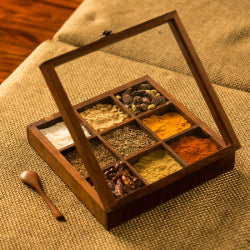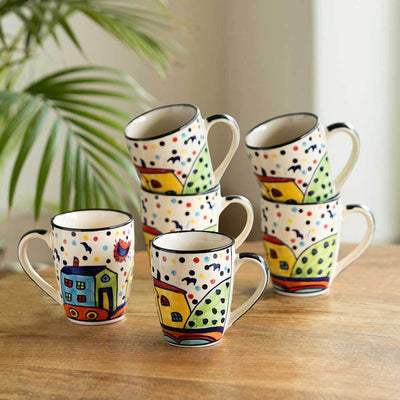Spices that you can find in every Indian Household's masala box
Spices, the friend of the physician, and the pride of cooks!

It’s said “live life with a little spice!” We all have our set of experiences which adds spice to our lives. Spices may be red or yellow, they hold the life and flavor of your food. Spices are the foundation of Indian dishes. Just with a dash of one pinch, your dish is transformed from nay to yay. Even the simplest ingredients can transform any meal and give them whole fresh life. Our spice cabinets are full of them, some mostly used, some rarely used, some kept for 'that' special dish, and so on. But we all have that special 'Dibba' of ours with 6-8 most used spices which we pretty much use in all our dishes. No matter what you are cooking, whether it is vegetarian or non-vegetarian, this Indian spice box or fondly known as 'Masala Dibba' always comes in handy. Masala container is a must-have in every kitchen, though one or two spices may vary from household to household, basic spices are essentially the same. After all, we all love some finger-licking spicy food! Spices add a distinctive flavor to bland ingredients, making them taste much better with just a little bit of spice.
So the question remains, what do we put in an Indian Masala Box? Although there is no such hard and fast rule about what 'must' go inside Indian Masala Box, it depends upon the region and family. Not just Masala, the Masala Box itself has distinct shapes and sizes. Some may go for unique Masala Boxes, others may go for Simple Masala Boxes. To your access, Exclusive Lane has a plethora of Designer Masala Boxes. They are a tool that quintessentially guides us through the entire process of cooking. So while you think of stocking up your Kitchen Masala Box, prioritize quality over quantity because it is a 'Medicinal Box' too consisting of Ayurvedic properties in spices. Your choice of spices and frequency of usage may change as you evolve in your cooking venture. Here are a few spices which always come in handy no matter what you prepare.
Different spices Used in Every Indian Household

Red Chilli Powder: There are a variety of red chillies available in the market, be it Kashmiri, Teekhi, etc. You can also opt to buy yourself saabut laal mirch and grind them on your own instead of buying red spice powder from outside. The fineness of the spice is one's own choice.
Turmeric: Turmeric is a brightly yellow colored powder that is not only known to bring deep-golden color to curries but also for its Ayurvedic benefits. It goes with everything, be it curries or stir-fried vegetables. It has anti-inflammatory properties which also makes it an amazing beauty ingredient!
Coriander or Dhania: This versatile spice adds a dash of earthy tones and texture to our curries, drinks, rasam, and vegetables. You may go for dhania seeds available in the market, roast them lightly and ground them. The aroma, the flavor is unforgettable.
Garam Masala or All Spice Mix: It is a quintessential warm spice blend that has a special place in all North Indian dishes. It gives deeper undertones to the dishes and is perfectly paired with spicy food. This masala is very much customizable and every family and region have their own version of this. The number of spices in the blend may range from 5 to 21!

Kaali Mirchi or Black Pepper: Black pepper is warm. When added to food, it gives a whole fresh aroma, depth, and heat. It can be added whole or ground, or as a seasoning in soups, pasta, and many other dishes.
Kasoori Methi or Dried Fenugreek Leaves: This dried herb has bitter undertones attached to it. You can crush it between your palms and release the aromatics. They are used in garnishing North Indian Dishes such as Kadhahi Paneer and Koftas.
Jeera or Black Cumin Seeds: These are used in rice dishes such as Pulao or Biryani. Black Cumin Seeds are milder than regular cumin seeds and are also an integral ingredient in making Garam Masala. They are the very first ingredient used in tadka and have a smoky, earthy taste that can be experienced with the very first bite.
Elaichi or Green Cardamom: As important as it is for curries, biryani, and vegetables, it is also an imperative ingredient for Indian sweets and desserts. It gives a sweet aroma with an earthy flavor. It can be used whole or it can be ground fine. If consumed as a whole, the outer shell has to be removed. Not to mention, it is the most relished spice by biryani lovers.
Lavanga/Namak or Salt: At last, The hero of the dish, one which can make or break the entire game. If your dish lacks salt, no other spice could ever compensate for its place. We cannot ignore its importance or presence in the dish.

Why was spice so valuable?
In ancient times, spices were used for cooking. Though they have been used mainly as flavoring and coloring agents, their role in food safety and preservation has also been studied in vitro and in vivo. Numerous health benefits of spices are demonstrated in the prevention and treatment of a variety of diseases, including cancer, aging, metabolic, neurological, cardiovascular, and inflammatory diseases. As a natural bio ingredient, spices offer a variety of potential uses in food preservation and shelf life enhancement as well as a comprehensive summary of the most relevant and recent findings on their active components. Just as the food absorbs spices, it is still incomplete without your love. Variety is the very spice of life that gives all its flavors. Spices were as valuable as gold and jewels in Europe during the Middle Ages and were among the most important drivers of the world's economy. As a result of the lack of refrigeration and poor environmental conditions, food often spoils quickly, and spices are often used to mask the taste of old, stale food. It is estimated that spices have existed since the dawn of time. During ancient and medieval times, spices were among the most valuable trade items. You can even read about the history of Indian spices here.






Quite an insightful note about our Indian spices and their importance. My Dad is very Particular about spices and I also asked him to read this writeup. We both enjoyed reading it and I came to know why my father push us so much for adding these spices to our meals.
Nice read! Every spice is very well explained. I’m fond of Indian Spices and all of these are present in my masala box but my personal favourite is Fenugreek leaves. I just can’t live without adding it to my dishes.
Omg..this blog about Indian spices has touched my heart. Infact, it will touch every Indian women’s heart… These are the base of any Indian kitchen.
Leave a comment